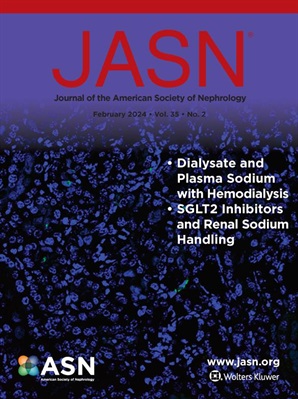mTOR Inhibitors and Vaccine Response in Kidney Transplant Recipients.
IF 10.3
1区 医学
Q1 UROLOGY & NEPHROLOGY
引用次数: 0
Abstract
BACKGROUND Failure to develop protective immunity in response to vaccination is common among kidney transplant recipients, rendering them susceptible to severe infection. Novel strategies are required. Here, we investigated the potential of mechanistic-target-of-rapamycin (mTOR) inhibitors to improve vaccine responses. METHODS Humoral and cellular responses to primary COVID-19 vaccination (ChAdOx1 or BNT162b2) were assessed for kidney transplant recipients receiving mTOR inhibitor-based (mTOR inhibitor, mycophenolate, prednisolone, N=15) and standard-of-care (tacrolimus, mycophenolate, prednisolone, N=40) immunosuppression, and healthy cohabitants (N=71), in a prospective observational study. Findings were validated and mechanisms explored in mice. Low/non-responding kidney transplant recipients receiving standard-of-care immunosuppression (N=54) were then randomized 1:1 to switch from mycophenolate to sirolimus, or remain on standard-of-care, for 4 weeks prior to receiving COVID-19 booster vaccination. Augmentation of immunity to COVID-19 was assessed as the primary outcome measure. RESULTS A 12-fold greater IFNγ-T cell response to primary vaccination was observed in kidney transplant recipients receiving mTOR inhibitor-based versus standard-of-care immunosuppression (520 vs 43 spot-forming units/106 cells, p < 0.001). A greater frequency of functional memory T cells in the mTOR inhibitor group was observed for both the CD4+ (0.20% vs. 0.05%, p < 0.001) and CD8+ (0.35% vs. 0.07%, p = 0.006) compartments by flow cytometry, and kidney transplant recipients receiving mTOR inhibitor-based immunosuppression produced greater frequencies of SARS-CoV-2-specific CD4+ T cells than healthy cohabitants (1.17% vs 0.48%, p = 0.03). In mice, sirolimus treatment enhanced both recall and de novo T cell responses to homologous and Omicron-specific booster vaccines. Switch from mycophenolate to sirolimus was well tolerated, however no significant difference was observed in the proportion of kidney transplant recipients in the intervention and control arms that achieved protective virus neutralization (10/25 [40%] vs 9/21 [43%] respectively, p = 0.85), nor in T cell response to vaccination (p = 0.89).Conclusions: mTOR inhibition was associated with improved T cell memory formation in kidney transplant recipients, however this effect was not reproduced by a short-term mycophenolate to sirolimus switch strategy.肾移植受者mTOR抑制剂和疫苗反应
在肾移植受者中,接种疫苗后不能产生保护性免疫是很常见的,这使得他们容易受到严重感染。需要新颖的策略。在这里,我们研究了雷帕霉素机械靶点(mTOR)抑制剂改善疫苗反应的潜力。方法在一项前瞻性观察研究中,评估了接受mTOR抑制剂(mTOR抑制剂、霉酚酸盐、强的松龙,N=15)和标准治疗(他克莫司、霉酚酸盐、强的松龙,N=40)免疫抑制的肾移植受者和健康同居者(N=71)对COVID-19初级疫苗(ChAdOx1或BNT162b2)的肿瘤和细胞反应。研究结果在小鼠中得到了验证,并探索了机制。然后将接受标准免疫抑制治疗的低反应/无反应肾移植受者(N=54)按1:1的比例随机分配,从霉酚酸酯切换到西罗莫司,或继续接受标准治疗,在接受COVID-19加强疫苗接种前4周。增强对COVID-19的免疫力作为主要结局指标进行评估。结果:在接受mTOR抑制剂的肾移植受者中,IFNγ-T细胞对初次接种疫苗的应答比接受标准免疫抑制的肾移植受者高12倍(520 vs 43个斑点形成单位/106个细胞,p < 0.001)。流式细胞术观察到,mTOR抑制剂组CD4+ (0.20% vs 0.05%, p < 0.001)和CD8+ (0.35% vs 0.07%, p = 0.006)区室的功能记忆T细胞频率更高,接受mTOR抑制剂免疫抑制的肾移植受者比健康的同居者产生更高的sars - cov -2特异性CD4+ T细胞频率(1.17% vs 0.48%, p = 0.03)。在小鼠中,西罗莫司治疗增强了对同源和欧米克隆特异性加强疫苗的召回和新生T细胞反应。从霉酚酸酯到西罗莫司的转换耐受性良好,但在干预组和对照组中获得保护性病毒中和的肾移植受者比例(10/25 [40%]vs 9/21 [43%], p = 0.85)和T细胞对疫苗接种的反应(p = 0.89)方面没有观察到显著差异。结论:mTOR抑制与肾移植受者T细胞记忆形成的改善有关,然而这种效果不能通过短期霉酚酸盐到西罗莫司的转换策略重现。
本文章由计算机程序翻译,如有差异,请以英文原文为准。
求助全文
约1分钟内获得全文
求助全文
来源期刊
CiteScore
22.40
自引率
2.90%
发文量
492
审稿时长
3-8 weeks
期刊介绍:
The Journal of the American Society of Nephrology (JASN) stands as the preeminent kidney journal globally, offering an exceptional synthesis of cutting-edge basic research, clinical epidemiology, meta-analysis, and relevant editorial content. Representing a comprehensive resource, JASN encompasses clinical research, editorials distilling key findings, perspectives, and timely reviews.
Editorials are skillfully crafted to elucidate the essential insights of the parent article, while JASN actively encourages the submission of Letters to the Editor discussing recently published articles. The reviews featured in JASN are consistently erudite and comprehensive, providing thorough coverage of respective fields. Since its inception in July 1990, JASN has been a monthly publication.
JASN publishes original research reports and editorial content across a spectrum of basic and clinical science relevant to the broad discipline of nephrology. Topics covered include renal cell biology, developmental biology of the kidney, genetics of kidney disease, cell and transport physiology, hemodynamics and vascular regulation, mechanisms of blood pressure regulation, renal immunology, kidney pathology, pathophysiology of kidney diseases, nephrolithiasis, clinical nephrology (including dialysis and transplantation), and hypertension. Furthermore, articles addressing healthcare policy and care delivery issues relevant to nephrology are warmly welcomed.

 求助内容:
求助内容: 应助结果提醒方式:
应助结果提醒方式:


